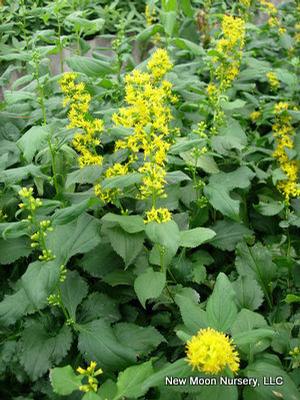Printed at http://www.newmoonnursery.com/index.cfm/
Solidago flexicaulis
Zig-zag goldenrod
Native to North America
FIRST IMPRESSIONS: Solidago flexicaulis is a perennial wildflower with upright unbranched stems. Stems are clothed in oval toothed leaves that gradually become smaller as the stems rise. From late summer into fall plants are topped with elongated yellow flower clusters. Smaller axillary flower racemes develop lower on the stem. Plants are tough and adaptable prospering in part sun or part shade and in moist well drained soil.
HABITAT & HARDINESS: Solidago flexicaulis occurs through central and eastern North America from Nova Scotia and Quebec to Georgia and from Ontario and North Dakota south to Louisiana.
Indigenous plants occur in rich deciduous woods, wooded east and north facing slopes, rocky woods, edges of floodplain forests, shaded calcareous seeps, wooded stream banks, edges of limestone glades and cliffs. This woodland goldenrod is usually found in undisturbed natural areas.
Plants are hardy from USDA Zones 2-9.
PLANT DESCRIPTION: Solidago flexicaulis is a clumping unbranched perennial wildflower. The central stem is green and smooth or pubescent. It usually changes direction or zig-zags between the nodes.
Leaves are 2-5” long and 1-4” across with somewhat winged petioles. They are ovate to lanceolate with sharply pointed tips and coarsely toothed edges. The blades are alternate gradually becoming smaller as the stems rise.
From late summer to fall, the central stalks are terminated by narrow panicles or racemes of golden flower heads. Smaller flower clusters occur lower on the stems originating in the leaf axils.
Each flowerhead is ¼” across with 3-4 ray florets and 4-8 disc florets. In autumn the florets mature into bullet shaped achenes crowned by tufts of hair. The achenes are distributed by wind and offsets form from the underground rhizomes.
Plants grow 3’ tall with 1-1.5’ spread.
CULTURAL & MAINTENANCE NEEDS: Solidago flexicaulis is a woodland goldenrod that prospers in mesic or dry soils. Plants tolerate some drought and loamy, clay or rocky soils.
Flowering and form are best with bright light or 3 hours or so of sun. Plants also tolerate total shade.
LANDSCAPE USES: This is a good choice for a Wildlife Garden or Shade Garden. Plants are used as Butterfly Nectar Plants or as part of a Grouping or Mass Planting. Solidago flexicaulis has Showy Blooms and is appropriate for Cottage Gardens, Water-wise Landscapes, Low Maintenance Plantings, Meadows, Perennial Borders, Roadsides and Restoration Projects.
COMPANION & UNDERSTUDY PLANTS: At woods edge try pairing Solidago flexicaulis with Aster cordifolius, Chasmanthium latifolium, Chrysogonum virginianum, Eupatorium colestinum, Heliopsis helianthoides and Amsonia hubrichtii.
If a substitute is needed, Solidago caesia is another woodland goldenrod with similar height and habitat needs.
TRIVIA: Native bees, wasps, butterflies and pollinating flies seek nectar and pollen from the flowers. Plants host caterpillars of several moth species. Seed are eaten by songbirds and upland game birds. White-tailed deer graze on the foliage.
Solidago flexicaulis and S. caesia are both woodland goldenrods with flowers that originate in the leaf axils. S. flexicaulis usually occurs in lower woods and has both terminal and axillary flower clusters and wider leaves with petioles. S. caesia usually occurs in upland woods and has only axillary flowers, blue or purple stem highlights and narrower leaves without petioles.
Height:
3 ftSpread:
1-2 ftSpacing:
2-3 ftUSDA Hardiness Zone:
2-9Bloom Color:
YellowSolidago flexicaulis Characteristics
Attracts Wildlife
- Pollinators
- Butterflies
Attributes
- Drought Tolerant
- Dried Flower
- Cut Flower
- Clay Soil
- Rock Garden
- Naturalizing
- East-Coast Native
Exposure
- Full Shade to Partial Shade
Deer Resistant
- Deer Resistant
Flowering Months
- October
- September
- August
Foliage Color
- Green
Juglans nigra Tolerance (Black Walnut)
- Yes
Soil Moisture Preference
- Dry
Interesting Notes:
For more information on this plant, visit the USDA PLANTS Database: http://plants.usda.gov/java/profile?symbol=SOFL2

